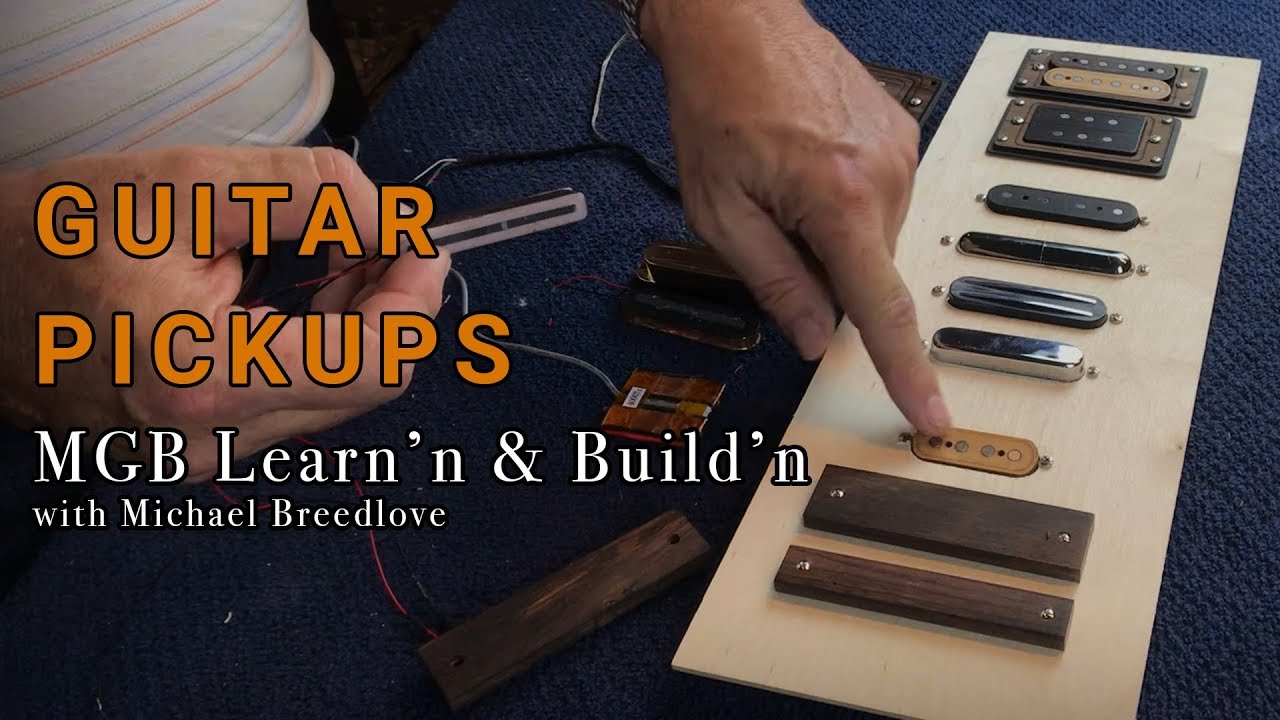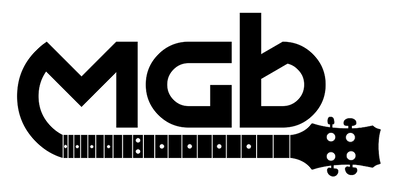Founder & Owner of MGB Guitars & Parts Supplier Michael Breedlove talks about everything you need to know about guitar pickups!
Watch the video here:
Want more videos? Subscribe to our YouTube Channel!
Video Transcript
let's talk about pickups I'd like to go over a little bit of the fundamentals of electric pickups Lisa ones we sell here at MGB pretty basic pickups fairly easy to understand but there's some basic concepts I just like to share with you then we'll kind of run through a number of the pickups we have in our line and talk about how you wire them which is the important thing basically a pickup is a very simple electronic device as you have probably noticed and have seen or experienced when you've fiddled with them that basically a pickup is a coil of wire and a magnet and the idea is based upon a principle that was discovered by a guy named Michael Faraday who kind of discovered the principle of magnets and coils of wire and when the two meet and when the magnet moves you get the production of a flow of current fundamentally that's how all electricity is produced or the vast majority of it there's some other ways of producing electricity but somewhere there's a generator where there's a magnet passing in front of a coil inducing a current and making the current flow and that's how we get our electricity it's a little bit of a simplistic construction but I think you'll get the idea I'm gonna look at a very very simple I mean this is as simple as it gets in our line this is the five-dollar make it holler nothing more than just a coil and this little magnet that I've kind of pulled out of the center so we could take a look at it I've got the the pickup hooked up or the coil at least hooked up to my little meter here and you can kind of see what's happening I've got the magnet here but I'm gonna switch over and I'm gonna use these neodymium a little more powerful magnet and a little more powerful reaction so again the coil of wire hooked up you see the reading is zero hopefully you can see it on the screen I think you come through pretty clearly but look what happens when I start moving the magnet around on the coil as you can see moving around you see the Volt reading jumping up and down making all kinds of different measurements it's actually that's would be a signal and if you ran it through the amplifier you'd get some noise now interesting when I leave the magnet and let it sit still well let it set still it falls back to zero for this principle to work the magnet or the coil or both have to be moving but as you know in most pickups it's kind of a stationary for example on the five-dollar the the mangas right there in the center just sitting here is not going to do anything so somehow we have to again follow the principle and we have to have a magnet that is inducing movement and into the coil and creating that current well the trick is it's the strings that do it and the magnet that's in the pickup to a certain extent magnetizes the strings and as you pluck those strings you pluck those strings they tend to go in an orbit they started going round and round and round and as they move they create the current that comes out of the pickup and of course then you can begin to get a signal again what I'll do is I'll simulate again using these neodymium x' and you can see as much as I'm moving around much like a string would do the magnet a string what you can do is you can see the meters start to read some current read the flow of current this is very simplistic and from here there's all kinds of improvements changes new technologies a lot of difference between this basic oil and a lot of the pickups that you see but the underlying principle is some kind of coil of wire and some kind of movement of some magnet to kind of create the flow of current and then that is the signal that goes into the amplifier and that's what you ultimately hear so I'm going to set this aside then we'll talk a little bit about the pickups that we have in our line go through as you know we can have a fairly broad line of pickups some very simplistic Sime a little more complicated like to just kind of work our way kind of through them and talk a little bit about them and talk about more importantly how you hook them up basically on the low end of our product line we have the five dollar and the Sun both basically just coils with magnets pretty straightforward they're a single coil we'll talk a little bit more about a single coil versus two coil humbuckers when we get a little bit further down the line but initially the beginning of the product line are just single coils and these single coils are just a coil of wire in a magnet sometimes a little different configuration as you can see when you took a take a look at a single coil on a single coil the this style you'll see a number of magnets so there's three magnets that can match up with the strings more directly or you can have a bar magnet that runs all the way across again there are all kinds of ideas strategies designs and ideas on how to make the magnets how strong to make the magnets the size of the coil it gets pretty complicated pretty quick so we're going to stay in the shallow end of the pool and just kind of talk about those kinds of things that we need to know basically so again we got a we got the five dollar we got a single coil we have these little tele pickups they're also a single call usually what you'll find on a single-coil pickup is usually just two wires and typically although it's not always followed there's kind of a color code here the black is the ground and that usually has to go to the ground on the pot and the red is what's called up now I get a lot of questions from some people and they they tend to see red and black and they maybe think a positive and negative these are not these are not positive and negative devices these are actually AC devices and so there's no there's no positive or negative there's just a hot and a common are hot in the ground however you want to take a look at look at those pickups so that's what we have again those are single coils pretty straightforward pretty easy to use we move up from there and we begin to look at some pickups that are double coil or basically humbuckers what you'll find is with a lot of the single coils they're basically large antennas and they'll pick up a lot of the EMF that's in the environment and that's how you'll get a hum on your on your your amplifier so a long time ago some guys were pretty smart and they figure it out hey if we took two coils we change the magnets around and wired them differently what we'd have is a noise canceling benefit that they it would actually the two coils working together would actually cancel the noise and that's why you get a humbucker because it bucks the hum so we have a lot of those we sell some of those again typically on this other end it's just a two wire connection when you get up into the humbuckers oftentimes you'll run into three wires and actually sometimes four wires and even more but basically sometimes you'll see just three wires and typically not always but typically what you'll see on a humbucker is a white wire and then you'll probably see a black and then you might see likely to see a red and a green wire that are already put together so again the way that it works is you have two coils in here and there's two separate coils two sets of wires coming off of them one is the black is on one side of one coil and then the green would be on the other side of that coil and then on the other side of the coil is the red and that goes around to the white so in theory if you disregard the red and the green and you just go from the white to the black you have a complete connection and the whole pickup will be working the whole pickup will be in the system now there are some applications in some instances where people like to split the coils and they want to have two single coils here and there's ways you can wire it to where you can have one single coil and then if you use a certain device you can actually put them together and have a humbucker so one pickup can be a single coil and a humbucker depending on how you control but that's that's pretty typical again on these hot real on these real hot real pickups you'll see the same thing a black for the ground white for the hut and then the red game for the center you'll see that a lot now recently we're coming out with what we call our hot tuna pickup it's a it's a really nice pickup a new pickup for us and it basically has kind of the same layout but the wires are a lot different the color coding is different on this what you'll see is you'll see and usually what you can usually tell is the jacket on the wire is usually the ground and in this case the jacket is connected to the green and that's your ground the black is your hot and then in this case we have a red and a white that are connected together those should lay aside and not be used again unless you want to split the quote so that's pretty much basic on how you do that one things I also like to tell people when I talk to about hooking up pickups and working with pickups is you know don't worry about testing what I have is that a little test device fixer I made here very simplistic just got a jack got a couple of wires that come off of it and that's the way I connect with my pickups and actually do some testing again these are the items that are actually making the current flow a lot of people are afraid about plugging stuff in because they're afraid they might blow something up or electrocute somebody or do something really bad here you don't have that problem with pickups it's a little bit of a different situation it's the pickup that's actually making the current flow and so you can actually do testing if you're not sure plug it into your ear and then you have these pigtails and you can just go and pick now if I've done my work accordingly what I can do is hook I better make sure I got the ground should have these color-coded of it now I'm gonna head up to the ground and I'm gonna hook this up to the hop and if I've done things correctly and I can find my tuning fork you can see I'm picking this up now if I want to just try and make this into a single coil all I do is move the hot over to the red green and essentially I've cut one one of the coils out just by listening to it you might not be able to tell over the video but it's about half the sound it's much much reduced so we went from a two coil down to a single coil and and it would be a humbucker but it would be a different sound and again that's something you can do I suggest making a little setup and trying stuff it's always best to do stuff on your bench top or your workbench or your table before you go installing the components and the guitar makes it a little easier here's another series of products we have that are pretty popular and those are our flat pickups kind of the same thing there's two wires coming off with them one is the braided jacket and that happens to be the ground and the other one is the hot and that's white and you can see these little flat pickups pretty sensitive makes a lot of noise so so again those are the pickups that's how you hook them up I hope this has been helpful we'll continue to put more videos out there to try and explain the more finite details of each pickup and help a little bit more but again don't be afraid to try something get yourself a test set up and get to learn your pickups it's always good to have a tuning fork rather than tapping on it whether with a screwdriver and that's a good way to test it so again hope this helps keep in touch Thanks




